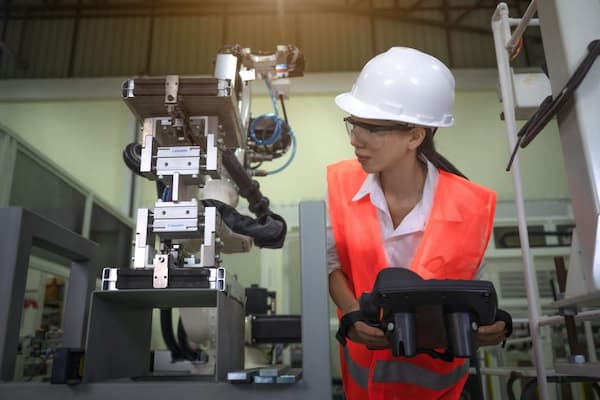News and Events
The robotics industry is constantly changing and evolving. New robotics technologies and developments in automation are quickly creating exciting career opportunities at every education level – from micro-credentials to PhDs. Here is where you can learn more about robotics careers in manufacturing and how these new technologies are benefiting workers


NEWS
Safety Considerations for Robot Operations in Manufacturing
October 1, 2024One of the most important benefits that robots bring to the manufacturing industry is the increased safety for workers. By taking over many of the most dangerous tasks, robots have greatly reduced the risk of injury to workers.
However, that doesn’t mean that safety is no longer a concern. Robots bring with them their own set of safety risks, and employees need to be trained on how to recognize and avoid those robotics risks.
In fact, a big part of robotics training is learning how to safely work with and around robots. Like any machine, safety considerations for robot operations must be implemented and followed to prevent accidents and mistakes.
Part of becoming a robotics technician is learning how to interact with robotics in a way that both enhances the machines’ ability to increase safety by troubleshooting during operation while creating a safe environment on the manufacturing floor.
Below, we’ll discuss both how robots enhance safety for workers and some of the biggest safety considerations for working with and near them.
How Do Robots Help With Safety?
There are many safety benefits that robots bring to the manufacturing industry.
To start with, robots create a safer working environment by taking on many of the most dangerous tasks and sparing workers the associated risks. For instance, robots in the automotive industry typically handle major welding operations that involve high amounts of heat that could cause serious injury. They’re able to repeat the tasks indefinitely without getting tired and making dangerous mistakes, , lessening overall robotics risks by avoiding the fatigue that human workers endure.
Robots are also often used to handle toxic materials that are dangerous to touch or paint spraying operations that could cause injury through inhalation or exposure. They’re also able to lift and move dangerously heavy materials throughout the manufacturing process.
By aiding in these dangerous tasks, they also help manufacturers achieve their safety goals in ways that would be prohibitively expensive otherwise. Increased safety for workers while boosting productivity means a stronger return on investment for manufacturers, and with the combination of standard workplace safety measures and safety considerations for robot operations, the workplace becomes safer for staff of all types.
Lowering safety risks often means saving money on medical expenses or insurance premiums, which is something most companies want to do. Also, a less dangerous working environment means less accidents that cause process shutdowns, maintaining profitability alongside safety.
As with any new technology, there’s also an adjustment period when employees need to learn about how best to interact with robots without putting themselves in danger of injury or error. This usually takes some time but leads to long-term safety improvements across the whole workforce once training has been implemented successfully. This is why it’s vital to strongly consider the safety considerations you’ll need for your robotic operation, as training your staff to safely interact with robots is paramount to safety in manufacturing.
What Are the Risks Associated With Robots in Manufacturing?
One of the safety concerns with robotics in manufacturing is that they can be unpredictable, or exhibit unexpected behavior.
It’s not uncommon for people to assume robots are infallible machines when it comes to safety – which isn’t true at all. Robot operations have a number of safety considerations associated with their normal operation including:
- Unexpected movements while operating if nearby workers are unaware
- Intense vibrations from high speeds and heavy loads causing objects nearby to fall over
- Sharp components on moving parts posing a risk if touched by employees
- Electrical shock from exposed wiring or malfunctioning power sources
In order to protect themselves against these types of safety hazards, workers need safety training to learn how to best interact with robots and their associated risks while working near them. This includes learning about what actions might cause malfunctions down the line and how to avoid them.
For example, it’s important for workers to keep their hands away from exposed components like spindles or sharp edges. If they need to access the robot during operation (to change its programmable safety features), employees should be sure not to remove any covers without first shutting down the machine.
These are just some of the safety considerations for robot operations in manufacturing at the present moment – but there are many more too! Employees need training on what safety risks come with robotics so that they can best avoid accidents while maximizing productivity at work.
The good news is that training to become a robotics worker is more attainable than you might think.
The Robotics Workers of the Future
While there are safety risks involved when working with any large machines, it’s undeniable that those risks are much less prevalent when it comes to working with robotics.
More and more industries, especially within manufacturing, are turning to robots to enhance their capabilities. That means that more and more people are going to be needed to fill the robotics workforce.
It’s our mission at RoboticsCareer.org to connect tomorrow’s robotics technicians, specialists, and robotics integrators with today’s best robotics education and training programs. Using our search tool on the home page, you can easily find the programs that are closest to your location. That means the only thing holding you back from a career in robotics is, well, you.
So what are you waiting for? Find your perfect robotics program today!


